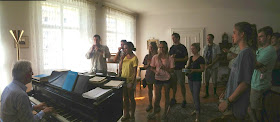Salzburg, Austria - one of my most favorite cities in the world! I love it because it's charming, friendly, touristy, and most of all: MUSICAL! I've spent the past five weeks teaching music in the UNO Innsbruck program and on Wednesday, July 31 had the tremendous fortune to take both of my music classes on an afternoon field tip to Salzburg.
We left with a packed lunch and our bus took us through incredibly beautiful Alpine valleys all the way there. When we arrived, we walked into the old town and met Professor Josef Wallnig at the Dom. Prof. Wallnig is a conductor and opera coach at the Mozarteum. Constanze Mozart had always wanted a music university in the city where her husband had been. When she married von Nissen, Constanze lived right in the middle of the old town. The Dom was closed for the moment because of preparations for the Jedermann play (held every evening at this time in the Domplatz). So, he took us into the Residenzplatz - where the lovely horse fountain is and talked to us about the Dom and surrounding buildings. He mentioned that long before the original Dom was built (in 774), the area of the square, underground, had been an outstanding Roman place of worship and before that a Celtic place of worship. The Celts had been in the area first and had established salt mines. The mines around Salzburg have been in use for 7,000 years! The history of the Dom is incredible. It suffered from MANY fires and was rebuilt each time.
 |
| view of the Dom from Prof Wallnig's rooftop |
Next, professor Wallnig took us to his apartment / house. He told us that it had been in his family for over 150 years and that it was here that Leopold Mozart came occasionally on business and often for the merchant theatre that happened in the area.
Just across the street lies the original Cafe Tomaselli. Leopold and Wolfgang Mozart (link is very good biography, right at one hour) used to come to this café and take coffee often. At the time, it was not ladylike for woman to be at cafés so Anna Maria, the mother and Maria Anna "Nannerl" we're notable to come. At a later time, Wolfgang's widow Constanze was given a written note from her doctor allowing her to have coffee for her digestive ailments.
Prof. Wallnig led us to the next floor where he gave us some water and elderberry juice. I noticed there was an Alpine hammered dulcimer, a guitar, a harpsichord, framed sheet music, a book from the late 1700's about Salzburg, and many old gorgeous, refined and interesting pieces of furniture. Then, he said it was time to work and gave out two bird water gurgling flutes, one wooden flute, and various small percussion instruments to members of my class and lined them up. They were nervous and giggly :-)
He told us that there was a tiny sinfonietta, the "Cuckoo" and that they were going to accompany him as he played the piano! I will try to upload the hilarious video once I get it! :-) :-)
 |
| Dr. Wallnig and my class perform! |
It was joyful, fun, and HILARIOUS and there was lots of laughter!
After this, we went up to the rooftop where we had a SPLENDID panorama of the city! Unbelievably cool! My students asked the professor a few questions and he talked to us about the festivals in Salzburg and his role in the Salzburger Festspiele. He gives pre-concert talks for all of the operas and sometimes gets to fill ion conducting! Many of his students are involved in the chorus, operations, or minor roles.
We then said our goodbyes and met our tour guide Brigitte who plays a type of folk flute and sings. She took us inside the Dom and talked to us about how it had been rebuilt several times and its architecture.
 |
| main altar of the Salzburger Dom |
 Each often had an organist and it was impossible to see each other so there had to be someone behind each organ keeping the pulse. There was also actually a fifth organ where the lowers altar is now. The four organs and various instruments - right under the main dome (73 meters) created a massive and quadraphonic sound.
Each often had an organist and it was impossible to see each other so there had to be someone behind each organ keeping the pulse. There was also actually a fifth organ where the lowers altar is now. The four organs and various instruments - right under the main dome (73 meters) created a massive and quadraphonic sound.
We scurried off to catch the opening procession of the Jedermann play and then made our way to Mozart's Gebursthaus.
 |
| Wolfgang Amadeus Mozart's Clavichord |
Our guide then walked us across the river where she told us a little about Herbert von Karajan. She told us of his large number of recordings and the story of hos he was supposedly to have helped determine normal CD length of 74 minutes due to his not wanting to interrupt a Beethoven's 9th symphony recording. Here's the snopes on that: Undetermined: http://www.snopes.com/music/media/cdlength.asp
 |
| Herbert von Karajan |
We ended with a walk through the lovely Mirabell gardens.
What a fabulous day!!
Salzburg, I WILL BE BACK!
Salzburg, I WILL BE BACK!
 |
| Beautiful Alps on the way to and from Salzburg |





Last month i was there in Salzburg with family and we had full fun, it was really a good trip.
ReplyDelete